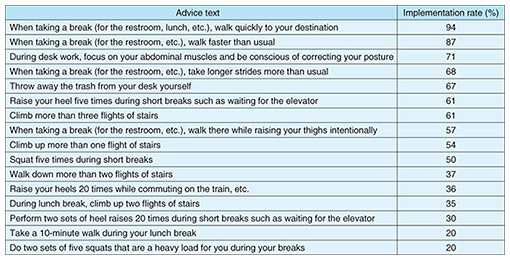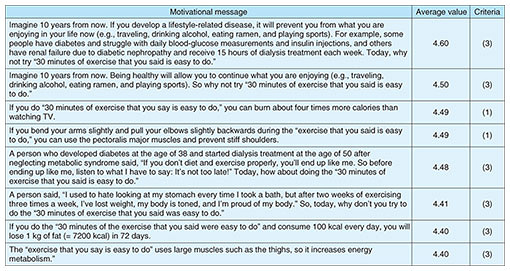 |
|||||||||||||||||||
|
|
|||||||||||||||||||
|
Feature Articles: NTT’s Medical and Health Vision toward Creation of Bio-digital Twin Vol. 19, No. 7, pp. 29–33, July 2021. https://doi.org/10.53829/ntr202107fa3 Behavior-change Support Technology that Brings About Positive Mental ChangesAbstractSocial issues, such as reducing medical expenses and promoting people’s health by improving their lifestyle habits, need to be addressed. This article uses lifestyle improvement as a use case to introduce a technology to support behavioral change by providing advice tailored to the individual’s personality. Keywords: mental change, behavior change, health promotion 1. IntroductionTo address social issues, such as reducing medical costs, three requirements must be satisfied: promoting health by improving people’s lifestyles, improving social environments, and encouraging preventive medicine. It is said that multi-stage life planning will be necessary when we enter an era referred to as the longevity society in which people will have lifespans of 100 years [1]. Diversity is required regarding work and relationships, but at the same time, how healthy people can live over that long lifetime is important. Considering these circumstances, we believe that it is important to support behavior change tailored to each person’s personality that brings about positive mental changes. Accordingly, we are aiming to implement technology that supports such behavior change in a manner that deeply understands each person’s hopes and what they cherish. We believe that such behavior-change support technology will be introduced into health-advice-presentation systems that can be used on a daily basis and into support systems for social-support*1 services. In this article, our efforts thus far and our newly launched narrative-type behavior-change support technology is introduced.
2. Research on behavior change concerning notification content, timing, and expressionWe first introduce our research on behavior change for improving people’s lives by presenting health advice, which has been one of our initiatives. There are services that provide advice on how to take action to improve one’s health via notifications on smartphones and smartwatches. For example, one service detects when a person is under severe stress and encourages them to take a deep breath [2], and another service encourages a person to stand up and move their body when they have been sitting down too long [3]. However, if the person who receives the message is not motivated to take the recommended action for various reasons, such as the timing is not right or the content is not specific enough, the likelihood that the person will take action (such as exercise) decreases. To encourage a person to take action after receiving a message, it is therefore necessary to tailor the content, timing, and expression of the notification to that person. With the above background in mind, we conducted an experiment on presenting specific advice on diet, exercise, and breaks to office workers. Specifically, the participants were sent various messages from a smartwatch app, and whether they actually carried out the advice in the messages was recorded during the experiment. The implementation rate for each message was calculated after the experiment (Table 1). The results listed in Table 1 show that the implementation rate is high if the advice is easy to follow. However, the most common reason for not being able to take the advice was that the situation or environment was not suitable to do so; for example, the advice was sent during a meeting (Fig. 1). We concluded that if the user’s life pattern is understood in advance and the presentation of the advice is tailored to the context, it will bring about a psychological change in the person who has the time to try it, and that change will lead to behavioral change.
We also studied how the message is expressed. We asked the question, “What kind of expression would bring about a mental change to try the same behavioral advice?” and came up with the following four criteria as patterns of motivation to engage in healthy behavior upon receiving the advice message. Focusing on the psychological phenomenon of cognitive dissonance [4] and time preference for future health [5, 6] proposed by Festinger, we devised an intervention message pattern to increase the psychological value of healthy behavior (Fig. 2). We prepared four messages that changed in accordance with the criteria.
The targets were people in their 30s to 60s who had received no previous guidance for the treatment of lifestyle-related diseases, were willing to lose weight, and were not in the stage [7] of maintaining behavior change regarding exercise and diet. We screened 162 people so that the population would be roughly equal in terms of personality traits (“Big Five”*2) and thinking traits (time preference). In a questionnaire, the participants were asked to imagine the situation in which they have about half a day at home doing nothing in particular but watch television and were in good physical condition and could exercise for about 30 minutes (including preparation time). They were then asked to answer the following question: “When you were notified (of the intervention message), did you try to do the exercise that you answered you said is easy to do?” We obtained responses using a six-point scale of 1 (not at all) to 6 (very much). When we looked at the messages with the highest scores, we found that messages related to improving future health had the highest scores (Table 2). We thus believe that by changing the content, timing, and expression of messages about recommended behaviors, the degree of influence on the recipients will change, and that change may lead to behavioral changes.
3. Behavior-change support focusing on narrative (narrative-type behavior-change-support technology)The efforts introduced above can be called “behavior-change support,” that is, changing someone’s behavior by encouraging them (nudging them) to elicit feelings such as “I think I can do it” and “Let’s try it” when the user seems ready to act. To establish behavior-change support, having a deeper understanding of each person’s hopes and what they cherish is important. We therefore focused on a person’s “narrative” regarding medical care and welfare, where the narrative is a story of an event from the perspective of that person. The narrative contains the person’s interpretation of an event to try to determine what the person values and dislikes from the narrative. Nonverbal information, such as facial expressions and gestures that the person makes when speaking, can also reflect the strength of the person’s emotions and values. Considering the facts described above, we want to draw out a narrative from each person, comprehensively understand the verbal and nonverbal information about the drawn-out narrative, understand the person’s personality from this information, and use it to support behavioral change. We call the behavior-change support brought about by such an approach “narrative-type behavior-change-support technology.” 4. Toward implementation of narrative-type behavior-change-support technologyCurrently, we are trying to understand patients’ narratives by conducting interviews with public-health nurses and patients regarding health consultation to extract their personalities that can be used for supporting behavior change. From interviews with public-health nurses who are skilled at eliciting behavioral changes of patients, we are proceeding with the hypothesis and its verification in regard to (i) how public-health nurses draw out patients’ stories during consultations; (ii) from what viewpoint do they try to understand the patient with respect to the medical-examination and medical-questionnaire data as well as the content and facial expressions of the response (i.e., narrative) from the patient during consultations; and (iii) what kind of advice should be presented in accordance with the characteristics elicited from the patient. We will refine our points of focus together with public-health nurses and present health advice that captures the personality of the person (including online). We also plan to verify whether that advice can cause behavior change and be applied to social support. References
|
|||||||||||||||||||















